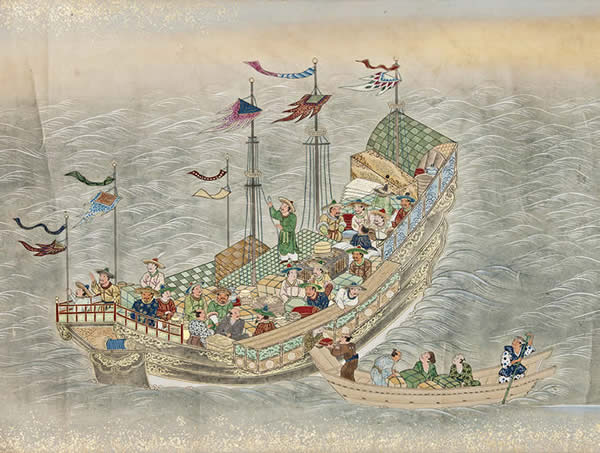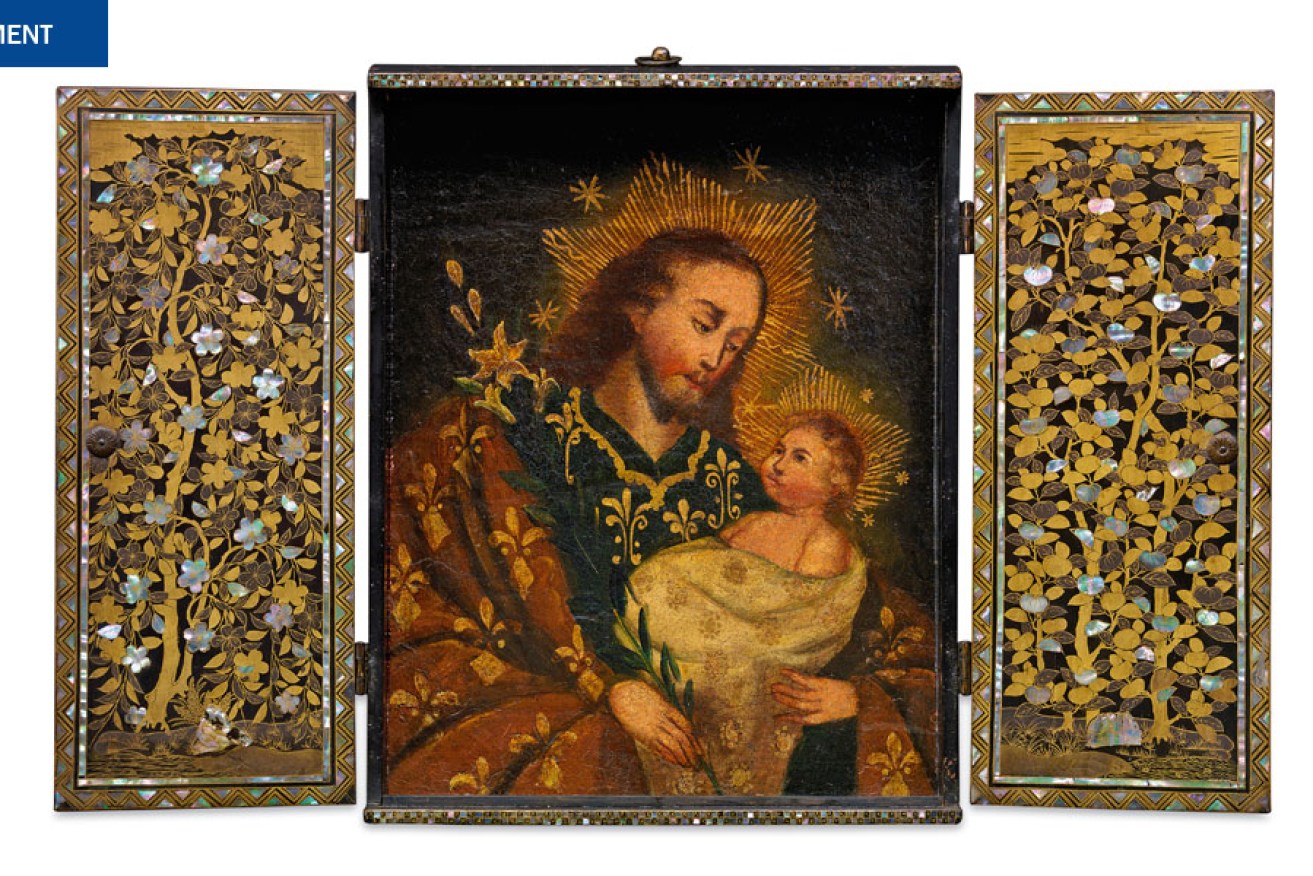Treasure Ships: Art in the Age of Spices is the first exhibition in Australia to present the complex artistic and cultural interactions between the East and the West from the 16th to the 19th centuries – a period known as the ‘Age of Spices.’
Showing at Art Gallery of South Australia until 30 August, the 300 outstanding and rarely-seen works of art reveal how the international trade in spices and other exotic commodities inspired dialogue between Asian and European artists.
The bridging of the gap between known and unknown worlds and the exciting commercial possibilities offered by contact with distant nations are encapsulated in Scenes of traders at Nagasaki.

detail: Nagasaki School, Scenes of traders at Nagasaki, late 18th–early 19th century, Nagasaki, Japan, pair of hand scrolls (e maki): ink, colour and gold on paper; box: wood, paper and ink, scroll (a) 34.0 x 652.0 cm; (b) 34.0 x 652.0 cm; box 12.0 x 19.5 x 39.5 cm, M.J.M. Carter AO Collection through the Art Gallery of South Australia Foundation 2014, Art Gallery of South Australia, Adelaide
Here, a Chinese junk, overladen with prized ceramics and lacquerware and carrying a complement of Chinese, Mongolian, Ryukyuan, Korean, Portuguese and Spanish merchants garbed in vivid textiles, makes its glorious entrance into the orderly port emporium of Nagasaki.
Extract from the Treasure Ships: Art in the Age of Spices exhibition catalogue. Authors: James Bennett and Russell Kelty
It has become commonplace to refer to the twenty-first century as the ‘Asian century’, with Asia’s cultural ascendency, nurtured by its burgeoning economies, defining a new international style of art that transcends East–West boundaries. Yet the rise of Asia on a global scale is not unexpected, despite Europe’s comparatively short-lived but aggressive adventure in nineteenth-century colonialism. Asia’s global rise began five hundred years ago in an era we closely identify with the extraordinary culinary and medicinal fashion, shared by both West and East, for spices.
The European demand for spices sent ships eastwards in order to discover their sources and to seek confirmation of the rumoured existence of Christian lands. To the surprise of merchants and seamen alike, they encountered sophisticated mercantile and cultural exchange networks stretching from the Middle East to East Asia. At the commencement of Europe’s so-called ‘Age of Discovery’, the waters of the Indian Ocean, Bay of Bengal, Java Sea and Vietnam’s Champa Sea, as the South China Sea was then known, were already well-charted shipping lanes.
The world was both remarkably similar and foreign to that we know today. The great port emporiums, like contemporary cities everywhere, were diverse multicultural melting pots. This period is often viewed as marking the birth of the Western diaspora, including to Australia, yet Chinese peoples had migrated overseas in far greater numbers during the sixteenth to nineteenth centuries. In doing so they created mixed-race communities whose cultural heritage is still evident throughout Southeast Asia and beyond. The terrible history of African– American slavery is well documented, yet human trafficking by local rulers and merchants in South and Southeast Asia was endemic. Today the descendants of these slaves form part of the multi-ethnic societies of India, Indonesia and East Timor.
The wealth and cross-cultural contacts engendered by the spice trade ensured that works of art – high-fired porcelain, textiles and carpets, lacquerware and furniture – became essential items of exchange in international commerce. Europe and the diaspora, as well as Southeast Asia and Japan, both of which were fashion-conscious societies, were hungry for manufactured foreign novelties. The demand inspired the creation of art styles whose hybridity, merging Western and Eastern aesthetics, often appears surprisingly modern.
Historians typically define the Age of Spices as spanning 1500 to 1800, encompassing the centuries from the Portuguese arrival in India to the collapse of the Dutch United East Indies Company. Nevertheless, the commencement of the English occupation of the Australian continent in 1788, with its subsequent colonial art, is a reminder that the aesthetic reverberations of the spice era continued in the Australasian region long after European ships had ceased carrying cargoes of nutmeg and cloves.
The Treasure Ships: Art in the Age of Spices exhibition catalogue is available from the Gallery Shop.
Treasure Ships: Art in the Age of Spices
Authors: James Bennett, Russell Kelty
Eighteen essays by International and national experts: Robert J. Del Bontà, Fr Jeremy Clarke, SJ, Bruce Carpenter, Wayne Crothers, Richard L. Wilson, Carol Cains, Judith Heaven
Hardcover, 320 mm deep x 240 mm wide, 352 pages, over 300 illustrations
ISBN 9781921668227
RRP $64.95 (special in store exhibition price $54.95)
Treasure Ships: Art in the Age of Spices
13 June – 30 August 2015
Art Gallery of South Australia
Tickets available now www.treasureships.com.au





